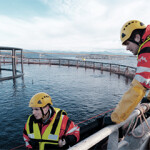Whole Oceans CEO Rob Piasio has big goals for RAS Atlantic salmon farm in Maine
Rob Piasio has grand ambitions.
Piasio is the founder and chief executive officer of Whole Oceans, which announced in February that it will seek to build a recirculating aquaculture system (RAS) Atlantic salmon farm in Bucksport, Maine.
Beyond his initial goal of converting an old paper mill into a state-of-the-art aquaculture facility, Piasio dreams of eventually capturing 10 percent of the domestic salmon market in the United States. And beyond even that, Piasio, a Maine native, is hoping to turn his home state into a global hub of RAS technology.
In an interview with SeafoodSource on Tuesday, 3 April (a full transcript of the interview is available with SeafoodSource Premium subscription), Piasio said his dream was born more than a decade ago. An investment banker at the time, Piasio was working on a deal involving Marine Harvest. Getting to know the aquaculture company sparked his interest in the field.
“I learned a lot about aquaculture at that time and found it – the industry – very compelling,” Piasio said. “I really liked the story, the economics, the opportunities within aquaculture. So I flagged that for future reference.”
When the global recession hit, Piasio decided it was time to pursue his passion project.
“I engaged pretty aggressively in researching the sector, different species, different technologies, the major players, and really starting with some macroeconomic research from the United Nations and World Bank. Through that process, I quickly settled on Atlantic salmon and utilizing land based RAS [recirculating aquaculture system] technologies,” he said.
RAS technology has advanced to the point where it is more viable, Piasio said, at the same time as the salmon market has made the finances of the huge investment required more feasible.
“Previously, land-based solutions for full grow-out were not cost competitive versus other methodologies. That’s changing, and it’s changing fairly rapidly as improvements in land-based technology continue, efficiencies is increased, and the [capital expenditure] for land-based systems is dropping rapidly,” he said. “And on the other side of the equation, the potential for expansion of offshore aquaculture is to some extent limited by the availability of new permits, particularly in respect to North American production and especially with respect to U.S. domestic production. So if you’re going to grow the U.S. domestic salmon production market, you have limited potential to do so with offshore operations.”
Piasio said it didn’t take long for him to decide he wanted to locate his facility in Maine, due primarily to its abundant water resources and positive reputation for supporting aquaculture. But finding an appropriate site took more than three years.
“It’s fair to say we looked at every potential site in Maine,” Piasio said.
The wait may have been worth it. During that exploratory phase, Piasio made a network of connections that included numerous aquaculture experts and many government officials, including Maine Governor Paul LePage and members of his administrative team, and officials in the Maine Department of Environmental Protection. Besides now having a stable of resources his team can turn to with questions, Piasio also has a good rapport with his regulators.
“Our approach has been patient and deliberate, so from a regulatory perspective, it has been important for us to work with the state to develop long-term solutions,” he said. “[Our business] requires long-term partnership, agreement, and understanding with the state. At every step of the way, we wanted to make sure everyone was very comfortable and fully on board with what was required from the regulatory environment.”
In February 2018, Piasio was finally able to publicly disclose his decision as to the location of the farm.
“Bucksport, by a wide margin, was the best [option],” he said.
Whole Oceans has contracted with Danish firm Billund Aquaculture to design its farm. In its first phase, the farm will have the infrastructural capacity to grow out 5,000 metric tons of salmon annually, as well as a hatchery that will allow Whole Oceans to have egg-to-harvest traceability of its salmon. In its entirety, the first phase of the project is expected to cost about USD 75 million (EUR 61.1 million). Piasio declined to say how much money his firm has raised thus far in total, but he said his company is “fully funded for all of our near-term goals in Bucksport.”
Through Billund, Piasio has gotten to know another similarly ambitious RAS project underway in the United States – Atlantic Sapphire’s aquafarm in Miami, Florida, which is now under construction.
“We’re very close with Atlantic Sapphire,” Piasio said. “We actively share information, and it’s just a great relationship for us.”
Piasio said he’s less familiar with the team behind the other large RAS project announced this year, the Nordic Aquafarms project planned for Belfast, Maine, but he’s not afraid of the competition.
“We believe that the market potential for production of domestic production of Atlantic salmon is so vast that it can accommodate many operators,” he said.
In fact, Piasio said he welcomes Nordic Aquafarms development in Maine.
“One aspect we’ve actively sought to develop in Maine is this sort of magnet or cluster-type of mentality for land-based aquaculture. The [Nordic Aquafarms development] will serve many advantages for our cluster, that we will be able to leverage together – suppliers, feed agreements, all sorts of input costs. In addition, and very importantly, we can leverage workforce development together,” he said. “Ultimately, on balance, we’re better having more operators in the state.”
Whole Oceans’ eventual goal is to produce 50,000 MT annually at its facility, or 10 percent of the U.S. Atlantic salmon market, but Piasio doesn’t foresee that happening for another 20 years. By that time, he hopes that Maine has become a “global center of expertise” for RAS salmon aquaculture.
“Our vision is not dissimilar to how Norway was able to develop its Atlantic salmon industry. In the early days of that technology, there was a lot of information-sharing going on,” he said. “It was used to the advantage of the entire industry in that country, and puts them in a position today where they’re in front. So it works.”
In the short-term, Piasio said Whole Oceans is planning to begin initial construction, starting with leveling the site, by August 2018.
“The goal would be to start construction prior to the winter, so we can get our concrete in before bad weather arrives, in which case we can be erecting the building, working inside through the winter,” he said.
Piasio approximated that it will take roughly a year before Whole Oceans can start to populate its tanks with fish, and then it takes another two years to grow the salmon out to a harvestable size, expected in 2021, if all goes to plan. Despite the long lag time until his company’s fish hits the market, Piasio said he still watches salmon prices closely.
“We monitor salmon prices daily,” he said. “One of the attractive aspects of salmon is that it’s a relatively transparent and liquid market with Nasdaq futures available for trading and hedging and price discovery. We will be actively using hedging tools like Nasdaq futures to hedge our pricing exposure.”
That’s playing it safe – Piasio said Whole Oceans already has a 10-year agreement with a distributor for the entirety of the company’s production. Piasio wouldn’t reveal the name of the distributor, but he said the company was interested in Whole Oceans’ product due to the “attractiveness of domestically grown salmon,” as well as its traceability, low carbon footprint, reduced transport costs, and freshness.
Piasio said he’s the project is about to begin, and to finally have been able to share his vision publicly. An estimated 250 residents attended Whole Oceans’ first public meeting in Bucksport on 20 March, and Piasio said he was encouraged by the response he received at that meeting.
“It’s critically important for us to be a part of the community. These are going to be our colleagues, our neighbors, and really wanted to develop this sense that we were neighbors, and working together,” he said. “We intend to be the next hundred-year industry for Bucksport.”
Photo courtesy of Bangor Daily News






Share